- Introduction
- What is Generative AI and how does it work?
- Key Benefits of Generative AI for Content Creators
- Top Generative AI tools to watch in 2025
- Companies Using Generative AI for Content Creation
- 1. HubSpot – AI-Enhanced Marketing Automation
- 2. Shopify – Product Descriptions on Autopilot
- 3. Netflix – AI for Creative Storyboarding
- 4. The Washington Post – AI-Assisted Journalism
- 5. Coursera & edX – Smart Course Material Creation
- 6. LinkedIn – Personalized Feed & AI-Generated Summaries
- 7. Airbnb – Dynamic Content for Listings
- 8. Adobe – AI for Visual + Written Content
- 9. Canva – AI for Everyone
- 10. Startups & Agencies
- What this means for Content Creators?
- AI and Human Content Teams: A New Creative Alliance
- Ethical Concerns in AI-Generated Content
- Final Thoughts & The Future of Generative AI for Content Creation
Introduction
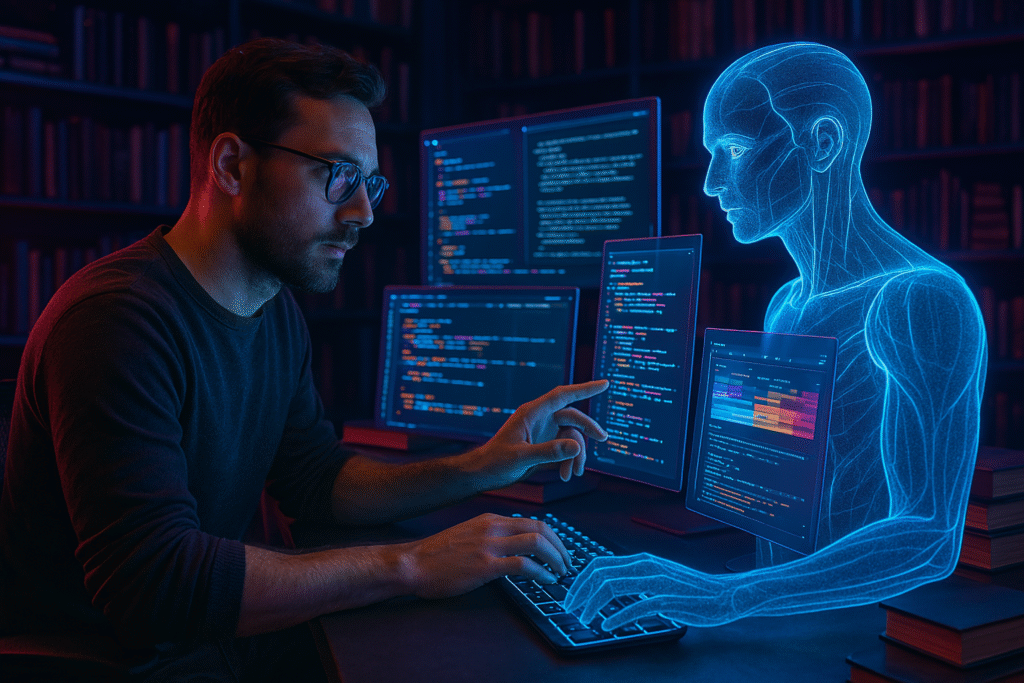
The way we create content is changing faster than ever. Whether you’re a writer trying to meet deadlines, a designer juggling client work, or a startup founder wearing a dozen hats, staying ahead of the content game is tough. But that’s where generative AI for content creation is flipping the script.
Tools like ChatGPT, Midjourney, and Jasper aren’t just fancy tech—they’re becoming everyday creative partners. With a few smart prompts, you can write blogs, generate visuals, draft emails, or even storyboard a video. And no, this doesn’t mean the end of human creativity—it means your ideas now have superpowers.
In this blog, we’ll break down what generative AI for content creation really is, how it works, and why it’s exploding in 2025. We’ll also look at companies already using generative AI for content creation, explore how creative teams are collaborating with these tools, and answer the big questions—like what this means for your job, your brand, and your future in a world where AI can create too.
What is Generative AI and how does it work?
If you’ve ever typed a prompt into ChatGPT or created artwork with Midjourney, you’ve already seen generative AI for content creation in action. But what’s really going on under the hood? Let’s break it down in simple, practical terms.
What is generative AI?
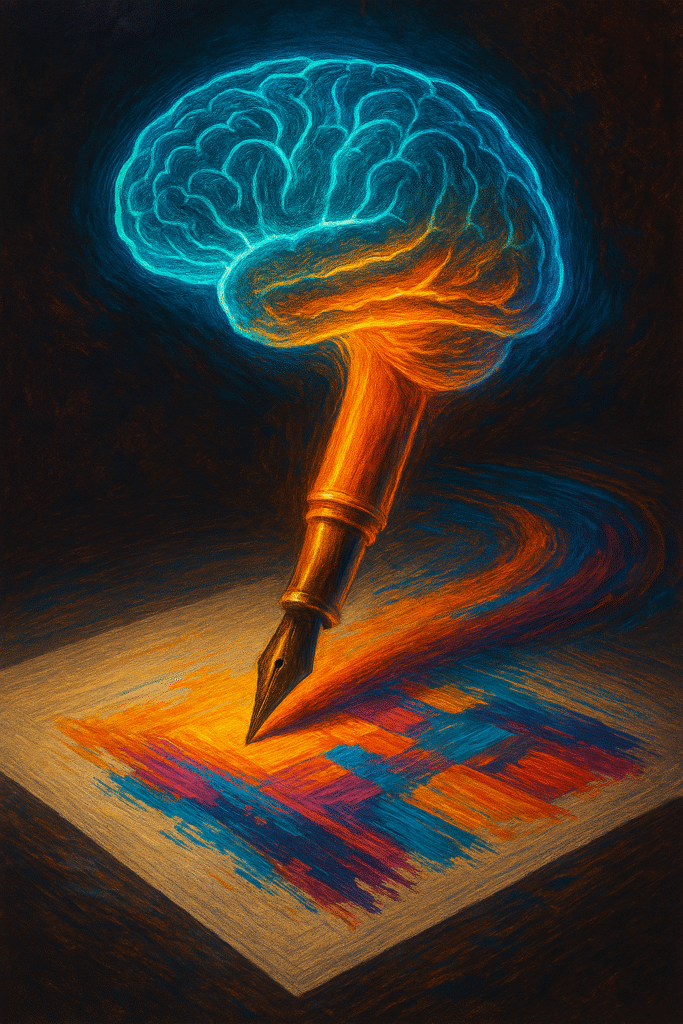
Generative AI for content creation is a type of artificial intelligence that can generate new content—like text, images, music, videos, or code—based on the data it has learned. Unlike traditional AI, which mostly analyzes or predicts, generative AI creates.
In content creation, this means you can use it to write blog posts, design graphics, draft email campaigns, or even build marketing videos—all in minutes. The tech behind these tools is often based on large language models (LLMs) like GPT-3 or GPT-4, which are trained on massive datasets to mimic how humans communicate.
How does Generative AI work?
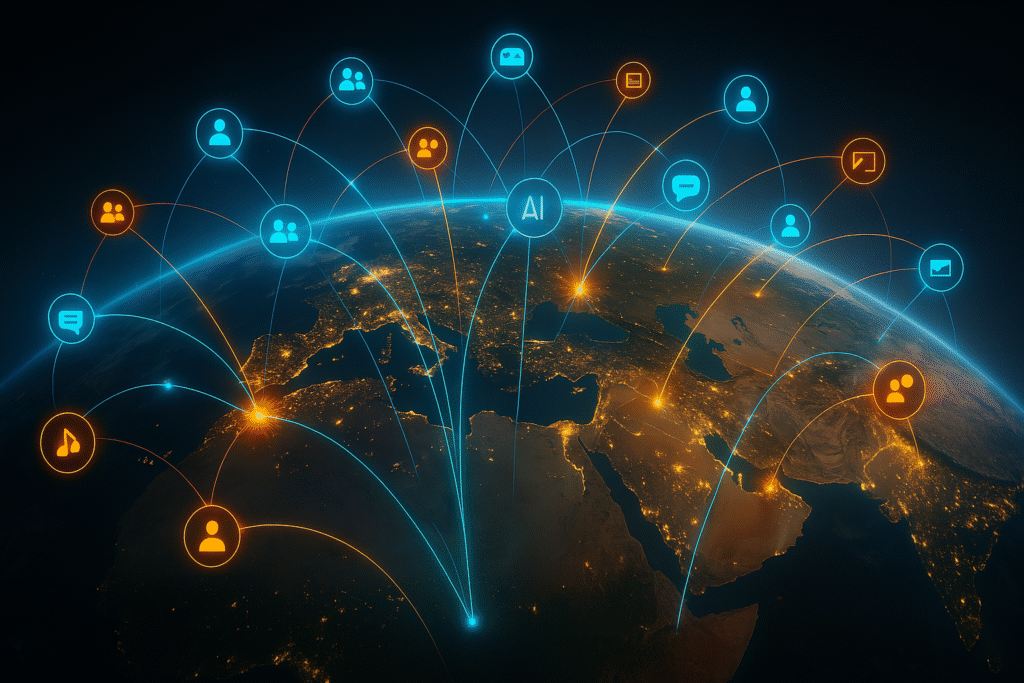
Generative AI tools use deep learning models—especially a framework called transformers—to process input (your prompt) and predict what content should come next. Here’s a simplified flow:
- Input Prompt – You ask: “Write a blog on startup trends in 2025”
- Pattern Recognition – The AI looks at its training data and finds similar patterns
- Output Generation – It creates a human-like response, customized to your request
This process happens in seconds and can be fine-tuned based on tone, structure, language, or even target audience. Whether it’s generative AI for content creation or AI design tools for creating infographics, the logic remains similar—input + patterns = new content.
What is the main goal of Generative AI?
At its core, the goal of generative AI is to enhance human productivity and creativity. It’s not just about automation—it’s about enabling creators to do more with less time and fewer resources. From brand storytelling to social media marketing, generative AI for content creation is empowering teams to ideate, iterate, and deliver at scale.
What’s the Key Feature of Generative AI?
The standout feature? Originality.
Generative AI for content creation doesn’t just pull from existing templates; it generates new material based on patterns it’s learned. Unlike predictive AI, which simply forecasts outcomes, generative AI builds something new every time.
What’s the Difference Between Generative AI and Predictive AI?
Predictive AI might tell you the best time to send an email. Generative AI for content creation will write the entire email for you.
| Feature | Generative AI | Predictive AI |
| Output | Creates new content | Makes forecasts or suggestions |
| Use Case | Content writing, design, media | Analytics, recommendations, lead scoring |
| Core Goal | Creativity | Accuracy |
Real-world Examples
- Bloggers use generative AI for content creation to outline, draft, and even headline-optimize their posts.
- Designers use tools like DALL·E or Canva AI to produce custom visuals from just a few keywords.
- Marketing teams automate landing pages, ad copy, and email workflows using tools like Jasper and Copy.ai.
Key Benefits of Generative AI for Content Creators
Whether you’re a solopreneur, a digital marketer, or a part-time creator, generative AI for content creation is quickly becoming a game-changer. But what exactly makes it so powerful—and why are creators in 2025 relying on it more than ever?
Speed and Scalability: Create More, Faster
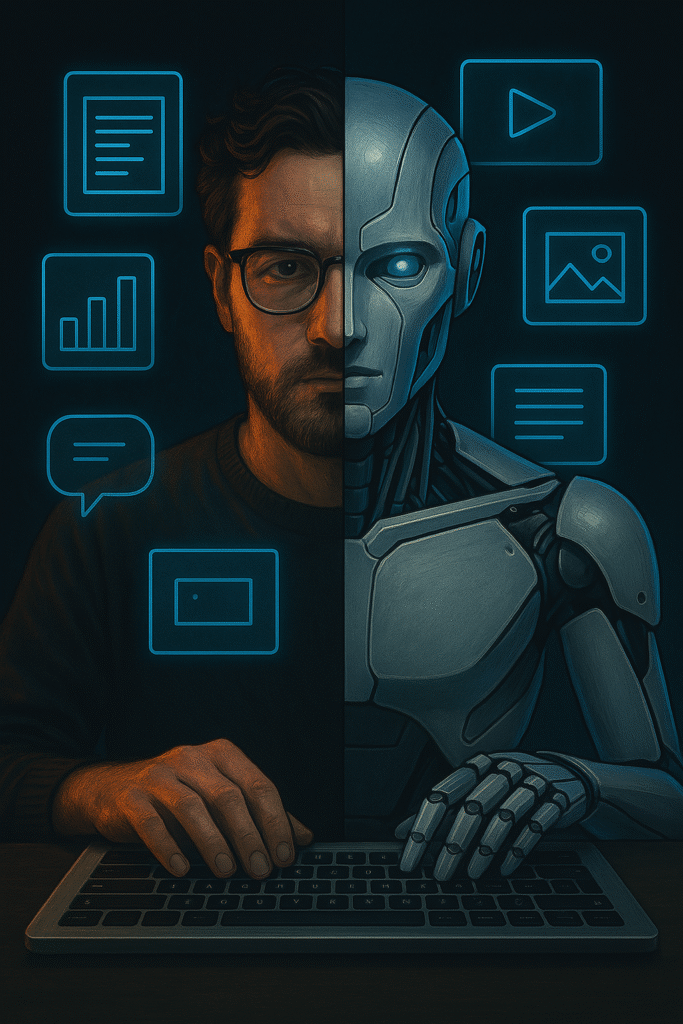
One of the biggest strengths of generative AI for content creation is its ability to generate high-quality content at scale. What used to take hours—blogs, captions, email campaigns—can now be done in minutes.
- Need a 1,000-word blog post? Done.
- Want 5 social media captions in your brand tone? Easy.
- Building a landing page draft overnight? Handled.
Tools in Generative AI for content creation allow creators to dramatically increase their output without hiring more people or burning out. That’s why tools like ChatGPT, Jasper, and Copy.ai are seeing explosive adoption among solo creators and startup teams alike.
Personalized & Targeted Content at Scale
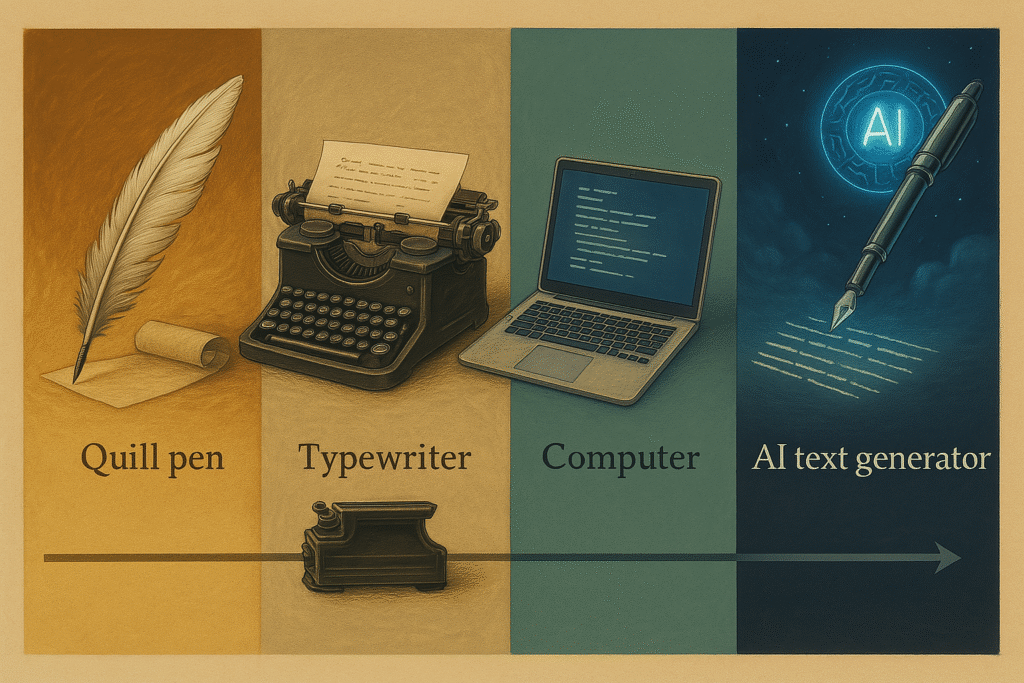
With traditional content, personalization often meant more time and cost. With generative AI for content creation, personalization can happen in real-time. You can tweak tone, voice, or even format to match different audience personas or platforms.
For example:
- A single product description can be instantly adapted for Amazon, Instagram, and LinkedIn.
- AI can generate region-specific or industry-specific variations with ease.
This level of dynamic, on-demand creativity was unthinkable just a few years ago.
Ideation Support: Say Goodbye to Writer’s Block
Creative burnout is real. But now, with AI productivity tools, brainstorming isn’t a solo job anymore. Generative AI can:
- Suggest blog titles
- Build outlines
- Write your first draft
- Improve readability or SEO in real-time
It’s like having a tireless creative partner who works 24/7, ready to assist whenever you’re stuck.
Cost-Effective Content Generation
Hiring multiple writers, editors, and designers can get expensive—especially for small businesses. With generative AI for content creation, you get high-quality drafts that reduce the time (and money) spent on initial creation.
Of course, human refinement is still key—but the heavy lifting is already done.
📉 Example: A startup using AI-generated email campaigns can save up to 60% in content production costs.
Collaboration and Workflow Integration
Modern generative AI tools for collaborative content creation like Notion AI, GrammarlyGO, and Canva AI are built to integrate seamlessly into team workflows. These tools allow multiple team members to co-create, comment, and refine content without jumping between apps.
This real-time collaboration not only improves speed but keeps everyone aligned creatively.
Accessibility and Inclusion
Generative AI for content creation helps level the playing field. For non-native English speakers, dyslexic creators, or visual thinkers, AI tools break down creative barriers. They offer voice-to-text, translation, summarization, and design support that make content creation more inclusive and accessible.
Top Generative AI tools to watch in 2025
In 2024, generative AI for content creation isn’t just a buzzword—it’s a competitive advantage. From automating blog drafts to creating viral videos or designing ad creatives, there’s a growing arsenal of AI tools designed to help creators and businesses move faster and smarter.
Here are the most powerful and practical generative AI tools to keep an eye on this year:
1. ChatGPT (OpenAI)
Use Case- Long-form content, brainstorming, editing
ChatGPT has become the go-to tool for writers and marketers. With GPT-4 and continuous updates, it helps generate entire blog posts, product descriptions, email campaigns, and more. It’s ideal for creators who want to scale generative AI for content creation while keeping control over tone and clarity.
2. Jasper AI
Use Case: Marketing copy, product listings, landing pages
Designed for businesses, Jasper is fine-tuned for conversions. It’s perfect for teams creating branded content at scale—especially in e-commerce or B2B. Jasper also supports collaborative workflows, making it a leading generative AI for content creation.
3. Midjourney
Use Case: AI-generated images, concept art, branding visuals
Midjourney is dominating the AI design tools space. With just a prompt, it can generate stunning, high-resolution visuals ideal for social media posts, ads, and website banners. For visual content creators, this is the future.
4. Canva AI (Magic Studio)
Use Case: Design + copy + video creation
Canva’s AI suite helps you build full-scale marketing assets—social graphics, videos, presentations—with smart copy suggestions and layouts. It’s the all-in-one toolkit for non-designers and creators who want to simplify their AI automated content creation workflow.
5. Copy.ai
Use Case: Ad headlines, social captions, SEO content
Copy.ai is a lightweight alternative to Jasper, ideal for quick, punchy content. It’s especially useful for solopreneurs and small teams looking for speed and affordability in generative ai for content creation.
6. Notion AI
Use Case: Collaborative documents, task automation, content structuring
Notion AI doesn’t just help you write—it helps you organize. From creating outlines to summarizing research, it enhances productivity across content teams. If you manage multiple content workflows, Notion AI brings clarity and efficiency.
7. Runway ML
Use Case: AI-powered video editing
Runway is turning heads with its ability to edit and generate videos using simple commands. For YouTubers and social video creators, it’s a peek into the future of creative work and AI.
8. GrammarlyGO
Use Case: Tone adjustments, rewriting, idea generation
Think of it as your personal editor—enhanced by AI. GrammarlyGO helps refine content tone, improve structure, and rewrite text for better clarity, making it a crucial assistant for any gen AI content creator.
AI Tool Stacks That Integrate Well
To make the most of generative AI for content creation, many creators build custom stacks using:
- Zapier (automation)
- Surfer SEO (content optimization)
- Lumen5 (text-to-video transformation)
These combinations bring together the power of multiple tools into a seamless workflow.
Companies Using Generative AI for Content Creation
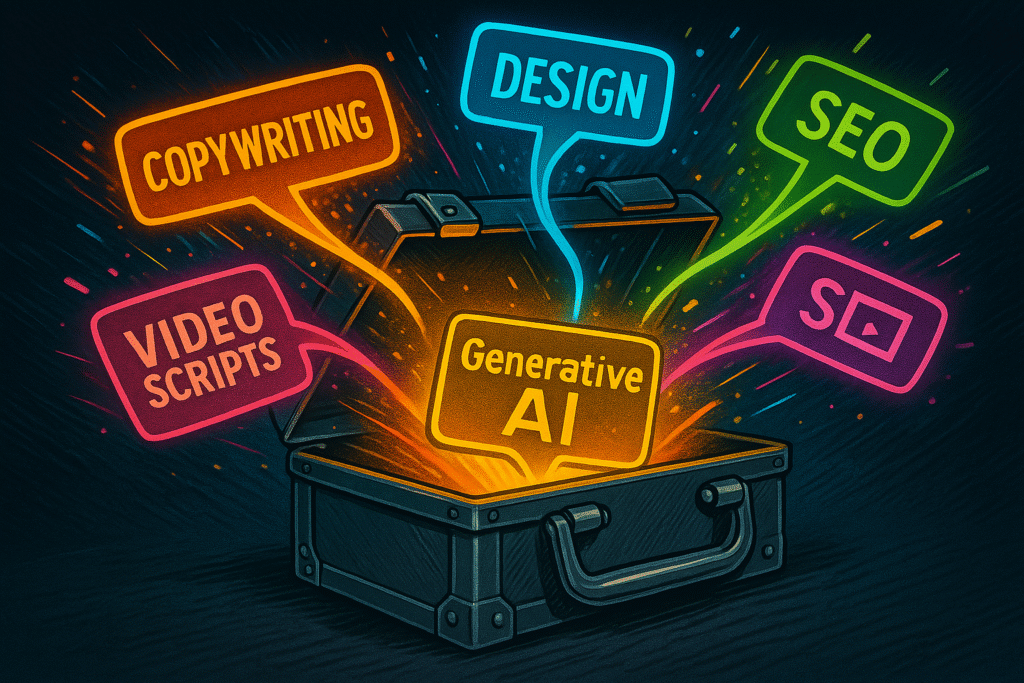
In 2025, generative AI for content creation isn’t just powering side projects—it’s embedded in the core strategies of global companies. From startups to Fortune 500s, brands across industries are using generative AI tools to speed up production, personalize experiences, and improve ROI.
Let’s break down how leading companies are leveraging AI for creative work, content marketing, and customer engagement.
1. HubSpot – AI-Enhanced Marketing Automation
Use Case: Blog generation, landing pages, email copy
HubSpot integrates generative AI tools like ChatGPT to assist marketers in creating long-form blogs, SEO-friendly headlines, and A/B test variants at scale. Their AI content assistant is now standard for inbound campaigns, streamlining productivity across marketing teams.
2. Shopify – Product Descriptions on Autopilot
Use Case: E-commerce content generation
Thousands of Shopify stores now use generative AI for content creation to automatically generate product titles and descriptions. It saves store owners hours while maintaining consistent tone and keyword-rich listings. They use proprietary integrations with tools like Jasper and Copy.ai for multilingual scalability.
3. Netflix – AI for Creative Storyboarding
Use Case: Concept development, script ideation, thumbnails
Netflix’s creative teams experiment with generative AI tools to storyboard new scenes, auto-generate promo titles, and design dynamic content thumbnails. This dramatically shortens pre-production cycles and allows testing of creative variations.
4. The Washington Post – AI-Assisted Journalism
Use Case: News summaries, fact-checking, content repurposing
Their in-house AI system, Heliograf, uses automation in creative industries to publish thousands of auto-written reports. Now, with generative AI, they repurpose long-form articles into social media snippets and personalized newsletters in seconds.
5. Coursera & edX – Smart Course Material Creation
Use Case: Course outlines, lecture scripts, quiz generation
Education platforms are using generative AI for content creation to draft course content and even personalized student feedback. It’s especially useful for micro-learning modules and fast-tracked certifications.
6. LinkedIn – Personalized Feed & AI-Generated Summaries
Use Case: Post suggestions, resume optimization, content engagement
LinkedIn is embedding generative AI tools to suggest personalized post ideas, write professional summaries, and draft conversation starters. These features boost user engagement and make content creation frictionless for professionals.
7. Airbnb – Dynamic Content for Listings
Use Case: Auto-generated descriptions and localized guides
Airbnb hosts are now supported with AI for content creation that generates compelling listing copy, neighborhood insights, and optimized headlines—all tailored to search algorithms and booking trends.
8. Adobe – AI for Visual + Written Content
Use Case: Photoshop AI tools, Firefly for image generation
Adobe is leading with AI design tools that allow creators to generate and edit images using natural language. Their generative fill and content-aware tools are redefining design workflows for freelancers and agencies alike.
9. Canva – AI for Everyone
Use Case: Social posts, email templates, brand kits
From students to startup founders, Canva’s Magic Studio suite offers generative AI for collaborative content creation—allowing users to generate text, visuals, and even videos in a single, intuitive interface.
10. Startups & Agencies
Companies like Rephrase.ai, Writesonic, and Lumen5 offer niche, plug-and-play gen AI content creator tools—ranging from AI video avatars to text-to-voice to ad scripts.
What this means for Content Creators?
Whether you’re a solo freelancer or a content team at scale, seeing how industry leaders use generative AI for content creation shows one thing clearly: AI is not replacing creativity—it’s accelerating it. And those who adapt early will hold a massive advantage in speed, consistency, and quality.
AI and Human Content Teams: A New Creative Alliance
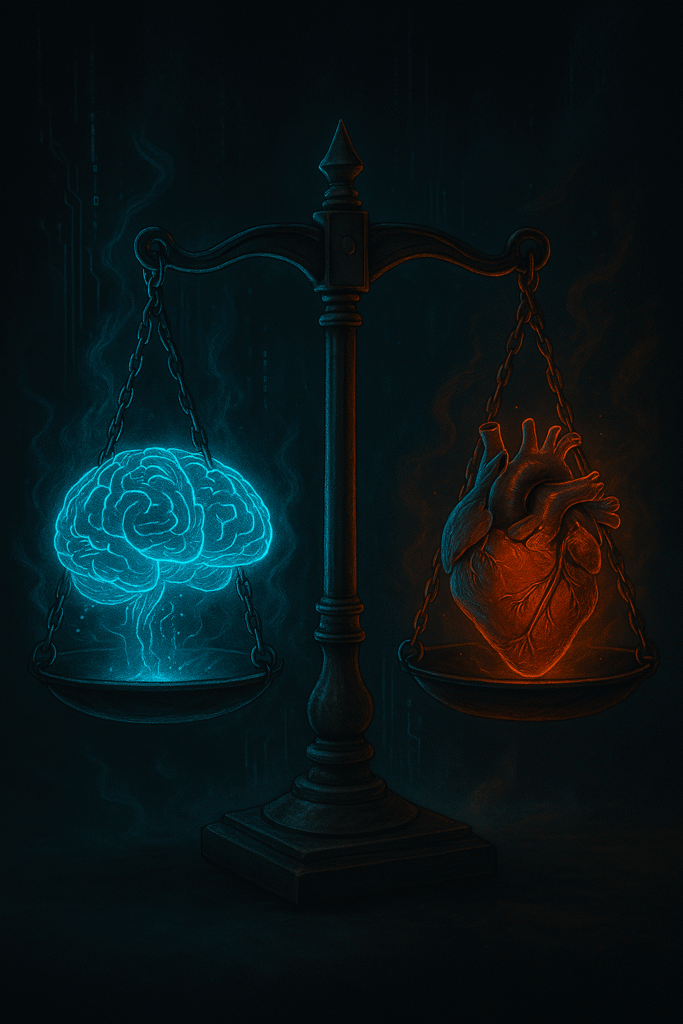
The rise of generative AI for content creation has sparked debates—Will AI replace writers? Can creativity be automated? But the most forward-thinking companies are asking a different question: How can human and AI teams collaborate to unlock better content?
Spoiler alert: the future isn’t man or machine—it’s man + machine.
Let’s explore how modern content teams are evolving with generative AI, and why the smartest organizations are doubling down on hybrid workflows.
The Rise of Collaborative Creativity
In today’s high-speed content world, humans bring emotion, brand voice, cultural insight, and ethical judgment. AI brings speed, consistency, data-backed suggestions, and round-the-clock output. Together, they can create magic.
Example hybrid workflow:
- AI drafts the blog/article →
- Human edits for tone, structure, and storytelling →
- AI optimizes for SEO and headline performance →
- Human reviews for nuance and strategic fit.
This reduces content production time by 50–70%, especially when using tools like Jasper, Notion AI, or GrammarlyGO alongside editorial teams.
Division of Creative Roles: What AI Can (and Can’t) Do
What AI excels at:
- Generating first drafts and outlines
- Rewriting content for different platforms
- Optimizing for keywords and search intent
- Brainstorming topic ideas and content gaps
What humans must still own:
- Strategic messaging
- Deep storytelling and emotional context
- Content rooted in brand values
- Handling sensitive or controversial topics
This AI-human synergy ensures content is not just fast—but authentic, impactful, and brand-safe.
Tools That Enable Seamless Collaboration
The best generative AI tools for collaborative content creation don’t just generate content—they integrate smoothly into team workflows. Here are some that enable efficient hybrid creation:
| AI Tool | Use Case | Best For |
| Notion Ai | Ideation + drafts | Writers, marketers |
| GrammarlyGO | Editing + Rewriting | Content editors |
| Copy.ai | Marketing Copy | Agencies & startups |
| Canva magic studio | Design + Copy | Social teams & freelancers |
| Surfer SEO | Optimization | SEO managers & bloggers |
These tools make it easy to co-create, iterate, and publish faster with fewer revisions.
Measurable Impact on Productivity
Teams using generative AI for content creation report:
- 2x–3x more content output per month
- 30–50% lower content development costs
- Better turnaround for campaign deadlines
- Higher engagement on SEO-optimized articles
As AI tools continue to learn and adapt, the productivity gap between AI-enabled and traditional teams will only grow wider.
The Human Edge: Why Empathy Still Wins
Even in an AI-first world, empathy, originality, and cultural relevance remain irreplaceable. The most viral content in 2025 still comes from human insight, not just perfect grammar or keyword density.
That’s why the role of the content creator is shifting—not disappearing. AI handles the mechanics of creation; humans lead the meaning behind it.
Final Takeaway
Generative AI for content creation is not a threat to content teams—it’s their most powerful partner. By embracing AI as a creative ally, teams can scale faster, work smarter, and still preserve the authenticity that audiences trust.
Ethical Concerns in AI-Generated Content
As generative AI for content creation becomes a mainstream tool in digital marketing, journalism, education, and creative work, it brings along a set of complex and evolving ethical challenges. While AI boosts productivity and democratizes access to content creation, the unintended consequences can’t be ignored.
Let’s break down the major ethical concerns that both individuals and organizations need to address.
Misinformation and Deepfakes
One of the biggest concerns around AI in content creation is its ability to generate convincing—but false or misleading—information. Whether it’s an AI-generated news article that lacks proper sourcing or a deepfake video that manipulates public perception, the risks are real and growing.
Example:
AI-generated news summaries can be outdated or factually incorrect if not manually reviewed—posing serious credibility risks.
Plagiarism and Intellectual Property Violations
Many generative AI tools are trained on publicly available internet data. This raises questions about whether the content they generate unintentionally replicates copyrighted material.
Key issues include:
- Writers unknowingly publishing content too similar to existing works
- Designers using AI art that resembles copyrighted imagery
- Lack of clarity on who owns the rights to AI-generated content
As regulations are still catching up, creators must use tools responsibly and with attribution where required.
Bias in AI-Generated Content
AI models are trained on datasets that reflect real-world biases—racism, sexism, cultural stereotypes, etc. This means the content they generate can also mirror those biases unless intentionally corrected.
Why it matters:
For companies using AI for content writing, publishing biased content—even unintentionally—can lead to reputational damage, alienation of audiences, and loss of trust.
Data Privacy and User Consent
When using AI automated content creation tools, particularly for personalized marketing, the ethical use of user data becomes critical. Generative AI can be trained or prompted using behavioral data, location, and past purchases.
Key concern:
Is the data being used with the user’s knowledge and consent? If not, it could violate privacy laws and ethical boundaries.
Companies must ensure GDPR and similar compliance standards are met.
Transparency and Disclosure
Another important ethical debate centers around transparency—should readers know when content is AI-generated?
Some platforms now require creators to disclose AI use (e.g., YouTube and Meta’s content labeling policies). Not doing so can erode user trust and raise issues of accountability.
Best Practice:
Mention when AI has been used in content creation, especially for journalistic or educational content.
Impact on Creative Jobs
While generative AI for content creation accelerates output, it also raises fears about job displacement in writing, editing, graphic design, and more.
Rather than replacement, the future should focus on upskilling human creators to work with AI—not against it. Emphasizing creativity, emotional intelligence, and critical thinking will future-proof human roles.
Final Thoughts: Ethics Must Evolve With the Tech
As AI becomes more embedded in creative workflows, ethical frameworks need to evolve in parallel. It’s no longer about can we use AI for content creation, but how we use it responsibly.
Companies and creators who understand and respect these boundaries will lead not just in innovation—but in trust and longevity.
Final Thoughts & The Future of Generative AI for Content Creation
We’re standing at a turning point in the evolution of content. Generative AI for content creation is no longer a futuristic concept—it’s a practical, everyday tool transforming how we brainstorm, write, design, and publish. From streamlining workflows to enhancing creativity, it’s changing the rules of the content game.
But what does the road ahead look like?
A Future of Co-Creation, Not Replacement
Despite fears of job losses, the future isn’t about replacing content creators—it’s about augmenting human creativity with intelligent systems. Writers, marketers, designers, and creators who learn to harness generative AI will thrive in faster, more flexible content ecosystems.
More Democratized Access to Creativity
In the coming years, we’ll see more freelancers, solopreneurs, educators, and small businesses leveraging generative AI tools once accessible only to large agencies. This levels the playing field, allowing anyone with ideas to create high-quality content quickly and affordably.
Platforms like Notion AI, Copy.ai, Jasper, and Canva Magic Studio are already empowering users at every skill level.
A Call for Responsible Innovation
As AI in content creation matures, so must our understanding of its ethical implications. Transparency, bias mitigation, and content authenticity will be non-negotiables for future-ready brands. Regulations around AI-generated content, IP rights, and disclosure will become more common.
Final Takeaway
The future of generative AI for content creation isn’t about machines replacing creativity—it’s about empowering more people to create, communicate, and connect at scale. For content teams willing to adapt, the opportunity is massive. For businesses that embrace AI responsibly, the growth potential is unlimited.
So whether you’re a creator, a founder, or a strategist—now is the time to experiment, learn, and lead.

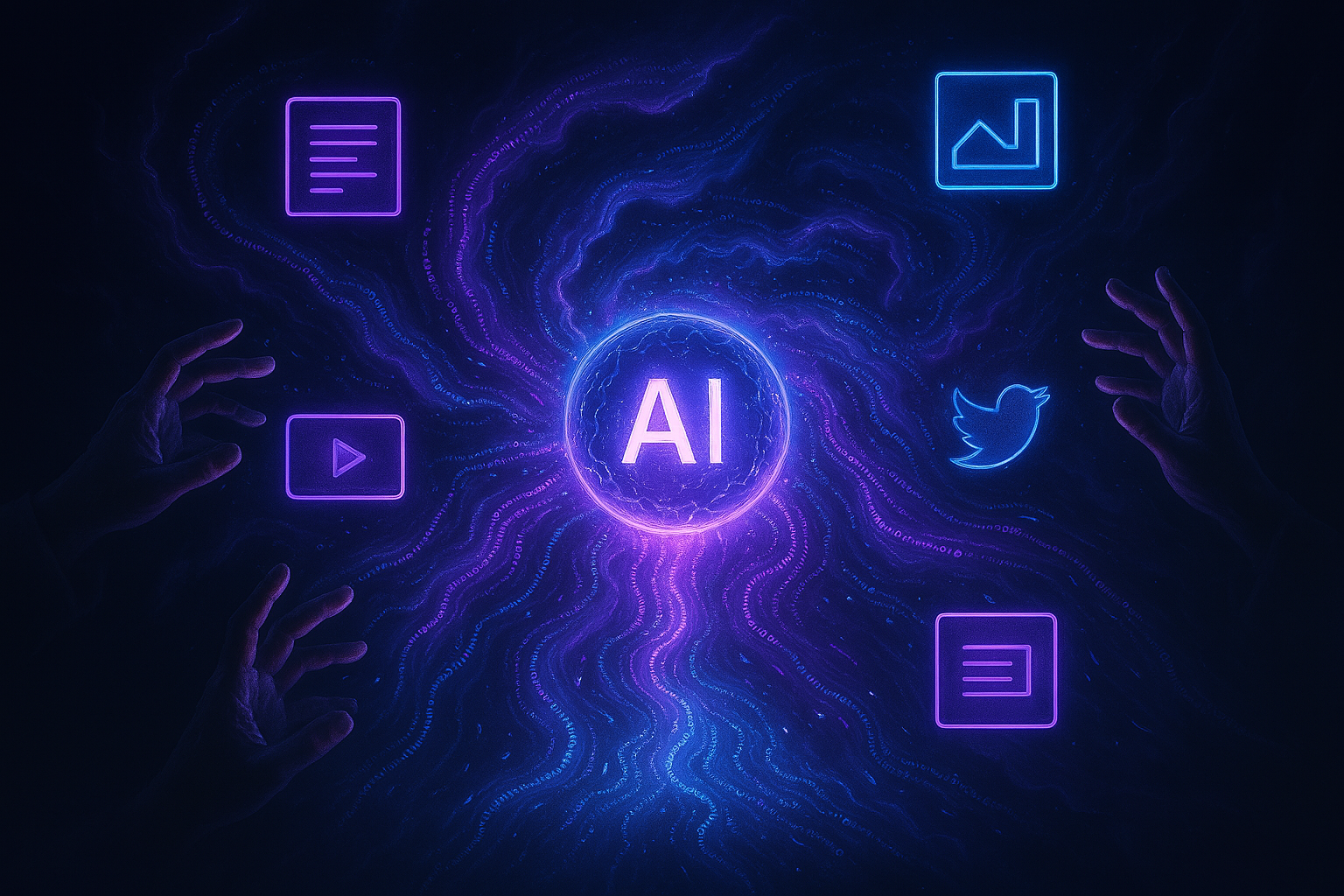
Leave a Reply